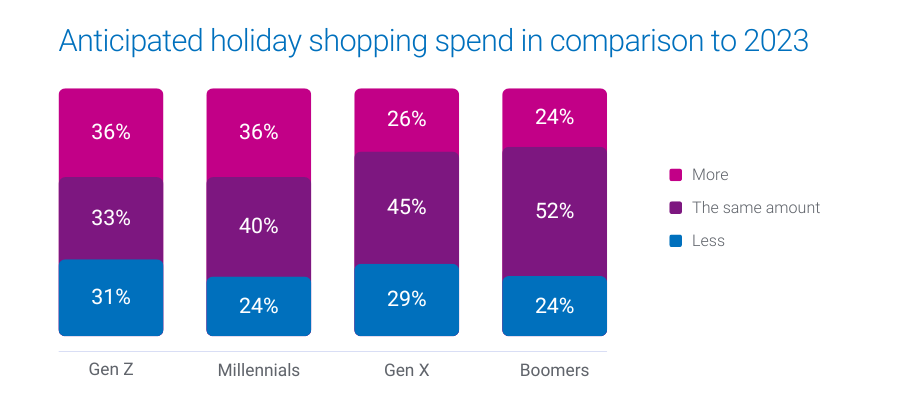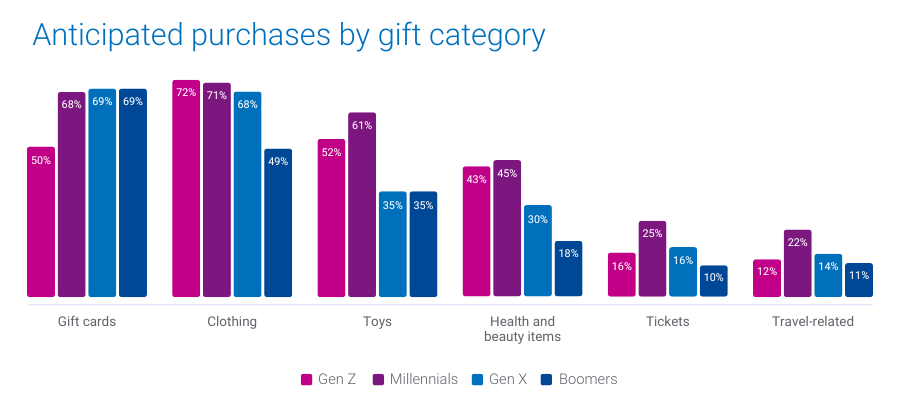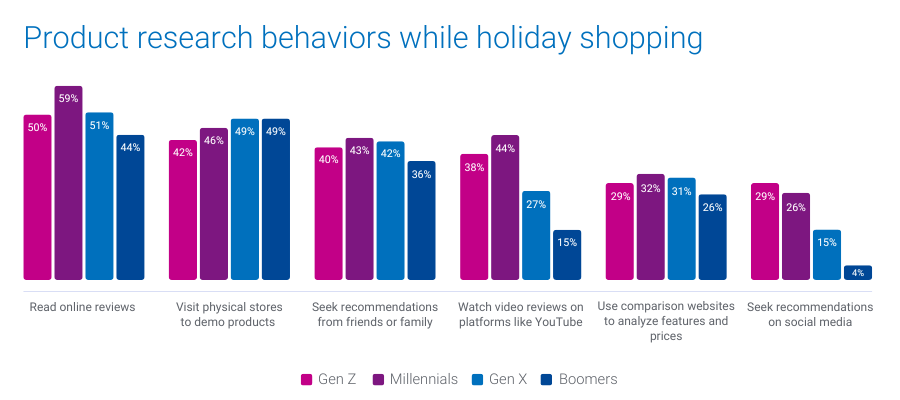
The holiday season is almost here, and knowing how each generation plans to shop can give your holiday advertising campaigns the edge you need. Our recent survey of 1,000 U.S. consumers reveals 2024 holiday shopping trends for each generation and key insights into their anticipated spending levels, preferred shopping categories, and how they look for gift ideas.
In this blog post, we’ll explore three 2024 holiday shopping trends across generations:
- Projected consumer spending
- Top categories on shoppers’ lists
- Preferred channels for researching gifts
1. Projected consumer spending
Over 1 in 3 Gen Z and Millennials are gearing up to increase their holiday budgets this year, while Gen X and Boomers are likelier to stick to last year’s budget.
- 36% of Millennials and Gen Z plan to spend more this holiday season
- 45% of Gen X and 52% of Boomers expect their spending to remain consistent with last year

What this means for marketers
These insights highlight the importance of tailoring your messaging. For Gen Z and Millennials, emphasize value and unique offerings that justify increased spending. For Gen X and Boomers, focus on trust and reliability, reinforcing their confidence in your brand.
How Experian can help you target these audiences
Experian’s custom and syndicated audience segments, including Holiday Shopper High Spenders and Holiday Shopper Moderate Spenders, enable you to connect with these diverse consumer groups. Our audiences are available on-the-shelf of leading ad platforms to help you reach people across social, TV, and mobile.
The election effect
U.S. holiday retail sales saw 4.1% YoY growth in 2016 and 8.3% YoY growth in 2020 following presidential elections. There’s a chance that holiday spending increases after the 2024 election, regardless of the outcome. Experian has 240+ politically relevant audiences that you can activate across major ad platforms ahead of the upcoming election.
2. Top categories on shoppers’ lists
Different generations have distinct preferences when it comes to what they plan to buy. Gift cards top the list for Gen X and Boomers, while Gen Z leans toward clothing. Millennials are looking to splurge on toys, electronics, and experiences.
- 69% of Boomers and Gen X plan to purchase gift cards
- 72% of Gen Z will buy clothing
- 45% of Millennials will buy health and beauty items
- 25% of Millennials will buy tickets and 22% of Millennials will buy experiences

What this means for marketers
Align your product offerings and promotions with each generation’s preferences to capture their attention. For example, highlighting versatile gift cards may resonate more with older generations, while showcasing trendy apparel and tech gadgets will appeal to younger consumers.
How Experian can help you target these shoppers
We offer audience segments like Holiday Shoppers: Apparel, Cosmetics & Beauty Spenders, and Toys Shoppers that you can activate to connect with consumers primed to purchase in these categories.
We recently released 19 new holiday shopping audiences we recommend targeting to drive engagement and conversions. Download our audience recommendations here.
3. Preferred channels for researching gift ideas
When it comes to finding the perfect gifts, Gen Z turns to social media, while Millennials prefer online reviews and video content. Boomers and Gen X are more inclined to visit physical stores for hands-on product evaluations.
- 29% of Gen Z and 26% of Millennials will look for gift ideas on social media
- 44% of Millennials will rely on video reviews and product demos on platforms like YouTube
- 49% of Gen X and Boomers plan to visit physical stores to evaluate products in person

What this means for marketers
Understanding where each generation looks for inspiration can guide your content and ad placement strategy. To engage Gen Z, focus on social media campaigns and influencer partnerships. For Millennials, consider investing in video content and reviews. For older generations, ensure your in-store experience is optimized to convert browsing into purchases.
How Experian can help you engage these shoppers
Our TrueTouchTM audiences can help you pair the perfect messaging styles with the right channels and calls to action. Our Social media channel and content engagement audiences can help you reach Gen Z who are likely to be active users on major social platforms and are Black Friday shoppers. For a full list of Experian’s syndicated audiences and activation destinations, download our syndicated audiences guide.
Download our report for five 2024 holiday shopping trends by generation
Understanding 2024 holiday shopping trends by generation can help you tailor your targeting, messaging, media planning, and creative based on the generation you’re targeting.
In addition to the insights covered here, download our 2024 Holiday spending trends and insights report to learn:
- When consumers plan to shop (hint: they’re already shopping)
- Where they plan to shop (online vs. in-store)
Download our full report to access all five of our predictions by generation, so you can address the diverse needs of this year’s holiday shoppers.
When you work with Experian for your holiday shopping campaigns, you’re getting:
- Accurate consumer insights: Better understand your customers’ behavioral and demographic attributes with our #1 ranked data covering the full U.S. population.
- Signal-agnostic identity solutions: Our deep understanding of people in the offline and digital worlds provides you with a persistent linkage of personally identifiable information (PII) data and digital IDs, ensuring you accurate cross-device targeting, addressability and measurement.
- Secure connectivity: Bring data and identity to life in a way that meets your needs by securely sharing data between partners, utilizing the integrations we have across the ecosystem, and using our marketing data in flexible ways.
Make the most of this holiday shopping season with Experian. Contact us today to get started.
Source
Online survey conducted in June, 2024 among n=1,000 U.S. adults 18+. Sample balanced to look like the general population on key demographics (age, gender, household income, ethnicity, and region).
Latest posts

The Republican and Democratic parties are gathering in the coming days to officially launch the Presidential campaigns of Mitt Romney and Barack Obama. In doing so, the candidates, the parties and their support groups will unleash unprecedented amounts of cash in an effort to influence American voters through advertising, much of it on TV. As such, Experian Simmons has released a new list of the top 20 television programs for reaching party loyals as well as three key swing voter segments. The segments come from the PoliticalPersonas consumer segmentation system, which classifies U.S. adults into one of 10 unique segments based on the individual’s political outlook and party ID as well as their attitudes and opinions towards key topics. The segments we will focus on in this post include the Super Democrats and Ultra Conservatives segments, which represent the most party loyal voters for Democrats and Republicans, respectively. We will also profile the TV preferences of three important swing voter segments during this election cycle, including: Mild Republicans, On the Fence Liberals and Green Traditionalists. For more information about the PoliticalPersonas segments, download the PoliticalPersonas Report. The shows in each list include those cable and broadcast TV shows with the highest concentration of viewers from each segment. For example, The Daily Show with Jon Stewart on Comedy Central has the highest concentration of Super Democrats of any non-news cable or broadcast show on TV. Likewise, Rules of Engagement on CBS has the highest concentration of Mild Republicans. Candidates, political organizations, and even traditional advertisers trying to connect with any of these voting segments would be wise to consider advertising on the programs listed below. For more information on PoliticalPersonas, watch our Webcast.

Marketers have always struggled to target the right consumer with the right offer. And with more than 313 million people live in the United States according to the U.S. Census, the challenge is more difficult than ever. With the proliferation of the Internet and mobile technology, today’s consumer operates differently and expects more from their favorite brands. To adapt to that new American consumer, marketers are using highly targeted strategies to drive interest. These can be messages that are relevant to a few hundred consumers or detailed one-on-one communications that target individuals at the point of sale or online. But some marketers struggle to execute these tactics effectively. Most segmentation is currently done prior to a campaign, meaning that marketers determine which message a consumer will receive before ever interacting with that individual. Unfortunately, with the rapid nature of purchasing decisions and buying transactions, businesses often miss opportunities because it takes too long to get the right message to the right consumer. To keep up, marketers need to collect intelligence at the point of contact so they can understand each individual consumer’s habits and preferences during that connection. This intelligence can then feed modeling algorithms that enable automatic offers based on an individual’s preferences. To develop a strategy around real-time marketing intelligence, marketers should take the following steps: Clean existing data – at the root of any intelligence strategy is data. Information determines a company’s ability to reach target individuals – and understand who they are and what they’re interested in. Unfortunately, if the data that feeds intelligence efforts is inaccurate, marketers are simply unable to communicate with or understand consumers. Ensuring the validity of contact information, internal records and third-party data elements helps organizations target consumers and ensures that sophisticated analysis is as precise as possible. Identify strategies – organizations should analyze their target markets and determine which communication channels could benefit from a more personalized customer experience. Marketers should decide how they want to change each communication to help drive the desired action from each consumer. Consider personalizing website displays based on geographic regions, customizing an introductory message or revamping loyalty campaigns based on purchase history and consumer interests. Real-time intelligence – marketers should build models to help predict the best offers for each target audience. These models can be designed to take into account demographic and behavioral information, as well as purchase history and internal data. Marketers can feed these models with intelligence gained at the point of contact to prompt consumers in real time with specific, relevant offers. As marketers continue to enhance and refine targeting efforts, it’s important to gain customer insight. Those who leverage these advanced technologies and strategies will create stronger customer engagement. Segmenting customers and taking measurable action in real time are advanced techniques that appeal to many marketers today. Achieving this level of interaction allows organizations to optimize marketing efforts and provide the right offer at the right time to the right consumer.

In a youth-obsessed world where fresh faces sell products, despite all efforts it’s a cruel reality that fashion models will eventually have to look for a new job. While they may try to self preserve with plastic surgery, Botox and laser treatments, let’s face it – they can’t be models forever. The advertising industry knows that a fresh face can’t be overlooked to sell products, so why should it be different for traditional direct marketers? Customers are the lifeblood of any business, yet businesses lose anywhere from 10-30% of them per year. Today’s “always on” shopper makes decisions in every channel – direct, online and in-store. In looking for better ways to sell more products to current and new customers, marketers seek out ways to expand their prospect universe to improve customer acquisition levels. Why? Customers are the lifeblood of any business, yet businesses lose anywhere from 10-30% of them per year. This makes new customer acquisition extremely important to both protect and grow business year over year. The acquisition challenge is that traditional prospect universe expansion is becoming increasingly difficult. Many marketers have exhausted list and co-op rental names, and optimization strategies. They’ve been using the same predictive prospecting models against compiled prospect data or co-ops for a long time. But these tools, which are based on traditional demographics, are increasingly leading to a decline in good prospect identification and acquisition. We know that in prospecting, there is no customer behavioral data to drive higher performing analytics – no plastic surgery or proverbial fountain of youth. In today’s multi-channel shopping world, the fresh face of online behavior can’t be overlooked. While direct marketers in self-preservation mode have leveraged traditional acquisition models for years, the reality is that if they do not consider fresh new data and modeling solutions, they will be looking for their next, new job. So, what can marketers do to overcome prospect universe expansion hurdles with online insight to increase acquisition and ROI? Meet direct marketing’s fresh new face: online behavioral data and modeling. Online behavioral data addresses a key challenge of traditional direct marketers: profitable prospect universe expansion. By incorporating online behavioral data (website traffic and behavior, search, demographics, lifestyle data) into offline marketing strategies, marketers can: Identify previously untapped prospect universes Suppress likely non-responders Enhance offline prospecting Where else do consumers so actively demonstrate their purchase interest and behavior? Where else do we go when we want to learn about something? Anything? We go online. But most direct marketers have not enhanced their offline marketing efforts with online data, missing the opportunity to incorporate online behavior into targeting efforts. With this fresh new data source, direct marketers are able to: Better understand customer behavior across channels Refresh their current models Develop better models, built from true, multi-channel data Ultimately, direct marketers will be able to identify new pockets of high-value prospects that traditional response models miss, resulting in an increase in revenues and profit. Fashion models and trends change, and sometimes that’s for the best, otherwise we might still be wearing parachute pants and slap bracelets. Luckily, you now know what the new face of marketing is and can begin integrating online behavior into your existing customer data today to leverage new marketing opportunities. Discover the new fresh face of direct marketing; learn more about online behavioral profiling and modeling.